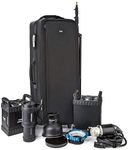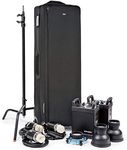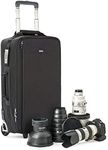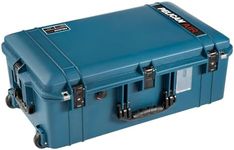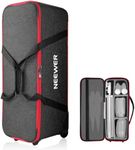Buying Guide for the Best Rolling Camera Bag
Choosing the right rolling camera bag is crucial for photographers who need to transport their gear safely and efficiently. A good camera bag not only protects your equipment but also makes it easy to access and organize your gear. When selecting a rolling camera bag, consider the type and amount of equipment you have, how often you travel, and the environments you typically work in. The right bag will offer a balance of protection, convenience, and durability, tailored to your specific needs.Size and CapacitySize and capacity refer to how much gear the bag can hold. This is important because you need a bag that can accommodate all your equipment without being too bulky or heavy. Bags come in various sizes, from compact ones for a camera and a couple of lenses to large ones that can hold multiple bodies, lenses, and accessories. Consider the amount of gear you typically carry and choose a bag that offers a little extra space for future additions. If you travel frequently, ensure the bag meets airline carry-on size restrictions.
Protection and PaddingProtection and padding are crucial for keeping your camera gear safe from bumps, drops, and other impacts. A well-padded bag will have thick, adjustable dividers that can be customized to fit your equipment snugly. Look for bags with reinforced corners and water-resistant materials for added protection. If you often shoot in harsh environments, prioritize bags with robust protection features. For casual use, a standard level of padding should suffice.
Wheels and HandleThe wheels and handle of a rolling camera bag determine how easily you can transport your gear. High-quality wheels should be durable and roll smoothly over various surfaces, while a sturdy, telescopic handle should be comfortable to grip and easy to extend and retract. If you frequently travel over uneven terrain, look for bags with larger, all-terrain wheels. For urban environments, smaller, smooth-rolling wheels may be sufficient.
Compartments and OrganizationCompartments and organization features help you keep your gear neatly arranged and easily accessible. A good bag will have customizable dividers, pockets for small accessories, and possibly a laptop compartment. Consider how you like to organize your gear and choose a bag that offers flexibility in its layout. If you carry a lot of small items, look for bags with plenty of pockets and compartments.
Material and DurabilityThe material and durability of a camera bag affect its longevity and ability to protect your gear. Bags made from high-quality, weather-resistant materials like ballistic nylon or polyester are more likely to withstand wear and tear. Check for reinforced stitching and durable zippers, as these are common points of failure. If you often shoot in challenging conditions, prioritize bags with robust materials and construction. For lighter use, a standard durable material should be adequate.
WeightThe weight of the bag itself is important, especially if you need to carry it for long distances or lift it into overhead compartments. A lighter bag is easier to handle but may offer less protection. Consider how much weight you are comfortable carrying and balance this with the level of protection you need. If you have a lot of heavy gear, a lighter bag can help reduce the overall load.



